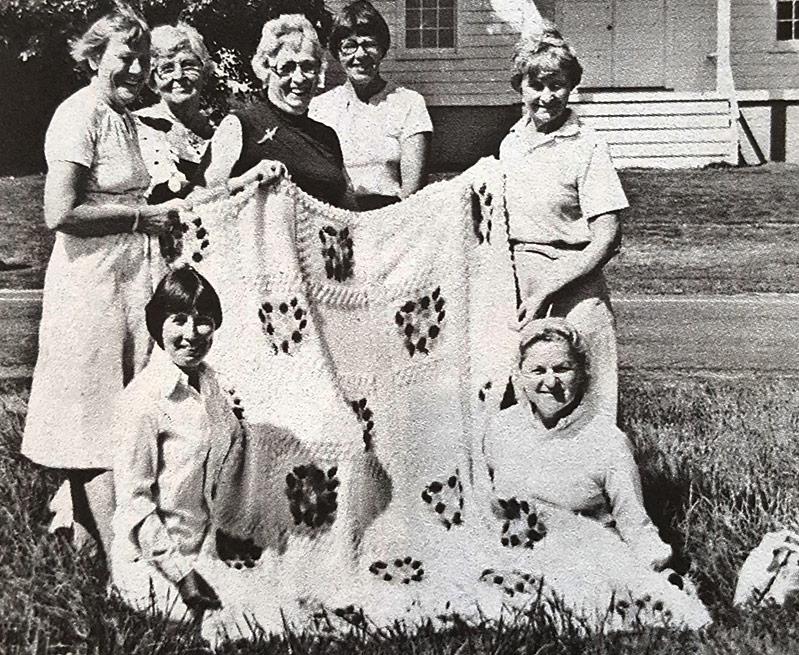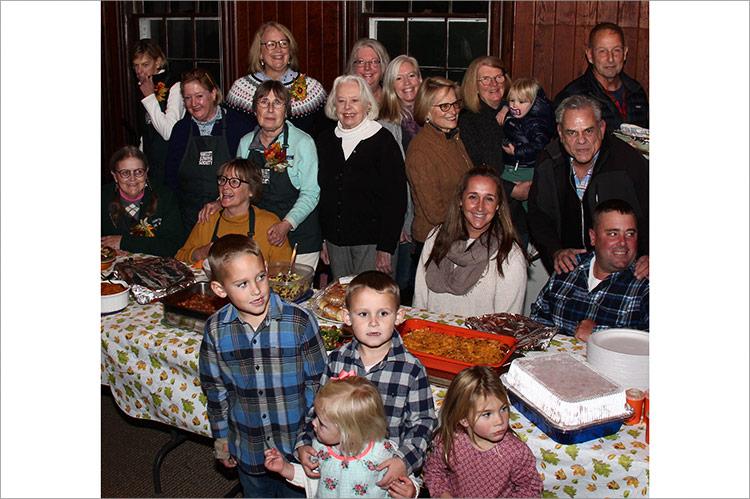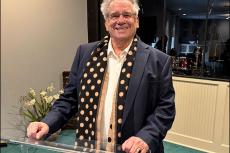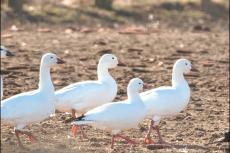The Wainscott Chapel has been many things, among them a community center, a schoolhouse, a venue for school plays, a meetinghouse for support groups, the longtime headquarters of the Wainscott Citizens Advisory Committee, an Election Day polling site, and a wartime Red Cross unit. It has hosted religious services, and in the tower there’s a bell on a long rope that can be pulled to ring it.
The chapel, however, was never blessed as a proper church for a particular denomination. For the last 150 years, it has been the charge of the Wainscott Sewing Society to manage and care for the building — from the war memorial out front to the privvy out back, and everything inside the walls in between. Founded in 1869, the Wainscott Sewing Society today is a social organization that brings the community together for festivals, history talks, and dinner parties, and raises money for scholarships and for the upkeep of the chapel.
“Our love of Wainscott is one of the things that connects us,” said Hilary Osborn Malecki, the group’s president. “A love of the chapel, a love of Wainscott community. It’s hard to socialize with people these days. We get together and enjoy seeing people that we don’t see on a daily basis.”
A poem written in 1927 by Mrs. Howard Hand described the founding of the Sewing Society: “In the year of 1869 / That seems to us a long long time / The ladies met a dozen or so / To organize a society to sew . . . These ladies worked from year to year / And helped with their gifts far and near.”
There are between 35 and 40 members now, from ages 24 to 87, but very little sewing happens these days.
“I was a member when we were doing sewing,” recalled Pat D’Andrea, the society’s secretary. “As older members passed away or moved on, newer members were not inclined to take up sewing, so we lost all the wonderful people that knew how to do these crafts.”
And, as Barbara D’Andrea, a third-generation member who is the society’s treasurer and Pat D’Andrea’s cousin, observed, “Women are now in the work force. They’re not home.”
Nancy McCaffrey, who served two terms as an East Hampton Town Board member and is on the board of the Eleanor Whitmore Early Childhood Center, remembered making a patch for a quilt that the Wainscott Sewing Society created together to raffle off many years ago, a frequent practice that raised money for the upkeep of the chapel.
“It couldn’t have been very fancy,” Ms. McCaffrey said, smiling. “I don’t have the patience.”
The society helped the Home for the Friendless, a New York-based mission, by sewing clothes and packing a barrel with supplies to send off to the city. During World War I and World War II, a Red Cross unit was established and the women of the sewing society wrapped bandages to be sent to the front lines.
“The high-society women at the time were into the Red Cross, so when these ladies called on you, you never said no,” Ms. Malecki said. “You wouldn’t say no to Bob Osborn’s grandmother! They donated money to the Red Cross and sent bags to their soldiers going off to war — the Wainscott boys. There were a lot of patriotic things around here.”

For the war memorial, the Wainscott Sewing Society is currently searching for the names of Wainscott veterans of the wars in Vietnam, Korea, Iraq, and Afghanistan. Those who have names to contribute may use the Contact Us tab on the organization’s website, wainscottchapel.org.
A turning point for the Wainscott Sewing Society came about four years ago when its members adopted new bylaws in recognition of the changing regional demographic. No longer is it exclusive to the women of Wainscott — now, those from East Hampton and beyond can join as long as they have a deep connection to Wainscott.
Ms. Malecki falls into that category. She is descended from a long line of Wainscott elders, though she lives in East Hampton now.
“Hilary has been a really important part of drumming up a lot of interest in the chapel, and we’ve been growing,” Pat D’Andrea said.
Tradition is important. The Wainscott Sewing Society has for many years sent flowers to people in town who are sick or experiencing other hardships and need some good cheer. The group has also hosted students for annual visits and hot-dog lunches dating back as far as anyone can remember. Looking out for young people is important; beyond the many humanitarian efforts, the group’s scholarship fund benefits alumni of the Wainscott School upon their high school graduations.
“There’s a sense of community. We get together, meet new people, and just enjoy the history of it,” Ms. McCaffrey said.
The society’s 150th anniversary very nearly came and went without a word of recognition. In September, when a beloved oil painting of the chapel was returned after missing from its place on the wall for about a year, Ms. Malecki shared some of the society’s history with The Star. Fast-forward, then, to Friday, when, during its annual covered-dish supper, the Wainscott Sewing Society marked its milestone with a huge sheet cake, enjoyed by four generations of Wainscott residents and friends.
Lots to Celebrate
A donor who asked to remain anonymous came forward recently to help the Wainscott Sewing Society in its effort to modernize the inside of the chapel and prepare it for another century or more of use by the community. The society had raised about $27,000 on its own and would otherwise have fallen short. Instead, by the end of the year, the building will have a new kitchen and running water on the public water supply, after its old hand pump broke and chemical tests of its well showed high levels of perfluorinated compounds — a regional pollutant, its origin currently under investigation.
The group also hopes to replace the old outhouse on the back of the building with an actual bathroom, and to build a handicapped-accessible ramp up to the rear entrance.
“We want Grandma to be able to come into the building and to go to the bathroom here,” Ms. Malecki said. That wasn’t a joke. “If we lose a wedding or a home-school group because there’s no proper bathroom, we’re concerned about the viability of the building. We’re trying to get over these hurdles so we don’t lose the rent [from outside groups] and we can keep this building the treasure of Wainscott.”
The group is also preparing to publish a fourth edition of “The Wainscott Dumplings,” written by Alice Osborn Hand in the 1950s. The memoir of growing up in Wainscott will be for sale soon; to order one, Ms. Malecki said, “talk to a lady in the sewing society.”
She has a photo of Jimmy Fallon, the comedian and late-night televison talk-show host, on the steps of the Wainscott Chapel, taken a few years ago on the day he helped the sewing society members unload boxes of donations for their annual rummage sale. Mr. Fallon owns a historical house on Parsonage Lane; some of its first residents were among the founders of the sewing society.
“We’re trying to be a central place to focus the community,” Ms. Malecki said. “As we lose the middle class out here, we’re losing a sense of community. The Boy Scouts have no scouts, the church pews are empty, the Lions Club and PTAs and neighborhood houses really struggle. It would be lovely for the mental health of future generations to follow the way it was — to provide community service and give outside yourself.”
How to Help
Become a member. The Wainscott Sewing Society now welcomes members who have ties to the community but may not live in Wainscott anymore.
Donate. The society appreciates monetary contributions as well as donations of old photographs, artifacts, and literature pertaining to Wainscott history.
Attend an event. Rummage sales, strawberry festivals, and historical talks all raise money and awareness of the Wainscott Sewing Society and its mission.




